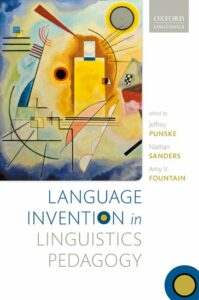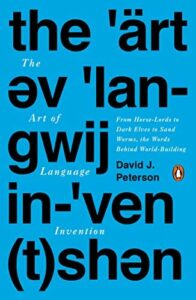
If you are reading this blogpost, you probably know what linguistics is. However, most people don’t know what to make of the term or have only a vague idea – it’s something about grammar, maybe? Those unknowing people would probably never choose a course titled ‘Introduction to Linguistics’ as an elective, as it sounds either too dry or too daunting. But what if introductory linguistics courses were taught under another cover – that of creating your own language?
Using language invention in the classroom has been increasing in popularity, and courses on language invention have been successful around the world. The book Language Invention in Linguistics Pedagogy explores this new field. It is edited by Jeffrey Punske, Nathan Sanders and Amy v. Fountain and was published by Oxford University Press in 2020. The book is centred around language invention in the classroom in all sorts of forms, from teaching introductory courses on linguistics with the help of language invention to teaching Proto-Indo-European as an invented language.
Invented languages are often called conlangs for short, which stands for constructed language. Conlanging is the creation of those languages – and conlanging is what this book is all about. A fun fact I learned from this book was that the term conlang was coined by famous Danish linguist Otto Jespersen in 1928.

The book has 15 chapters by various authors, many of them well-known names in the conlanging world. There are chapters by Arika Okrent (In the Land of Invented Languages), Jessica Coon (Arrival) and David J. Peterson (Game of Thrones and much more), to name just a few. Some chapters are written in an engaging language, others resemble scientific articles, which makes it a book to read bit by bit rather than all at once.
In chapter 2, there is a short introduction to the history of conlanging, setting the other chapters into perspective. Together with chapter 3 on how to find possible to-be-linguists, it offers a nice introduction to the following chapters on conlang-courses. Those courses were taught for students at all levels, from primary school children to graduate students. Most of the described courses focus on undergraduate students.
One of the main aims of many of the courses was to introduce students to linguistics, whether they are high school students or undergraduates with another major. Most people don’t know what linguistics is, but many have heard about the Elvish languages in The Lord of the Rings, Na’vi in Avatar, or Klingon in Star Trek. This growing interest in conlangs by fans of large franchises can be used to introduce a niche-subject.
Courses on inventing and/or invented languages can be used to teach about language and linguistics. In conlanging, language is not treated as some abstract entity to be read and theorised about but as something you can create yourself. By creating a naturalistic conlang (i.e., a conlang that behaves like a naturally occurring language such as English or Mandarin Chinese), one must understand the way in which natural languages work – and this is where linguistics comes in. Students can unfold their creativity while at the same time learning about phonetics, phonology, morphology, syntax, semantics, pragmatics, and other areas of linguistics. Because of this broad scope, courses on language invention can work as introductory courses to linguistics. Grant Goodall (chapter 6) puts it beautifully: “By learning how to design a language, students learn about the design of language.”

For students majoring in linguistics, a course on language invention can help apply and test their theoretical knowledge of language, showing them not only how much they have learned in previous courses, but also the gaps in their knowledge. It’s so much more fun to research a phenomenon because you need it to make something in your language work than if it were for an assignment.
I have learned so much about linguistics by creating my own language, and as this book shows, I’m not alone. So, when is there going to be a course on language invention at a university in Denmark?
Geertje Graehn is a BA-student of Linguistics at Aarhus University. In her first semester, she wrote an exam paper about fictional languages, and she has been hooked on the topic ever since. Together with two other students, she started SOLIA (Student Organization of Language Invention Aarhus) in spring 2022 and has had heaps of fun creating her own conlang since. With SOLIA, she has given short conlang-workshops at Aarhus University as well as at a language festival for high school students, introducing as many people as possible to the wonderful world of conlanging.







